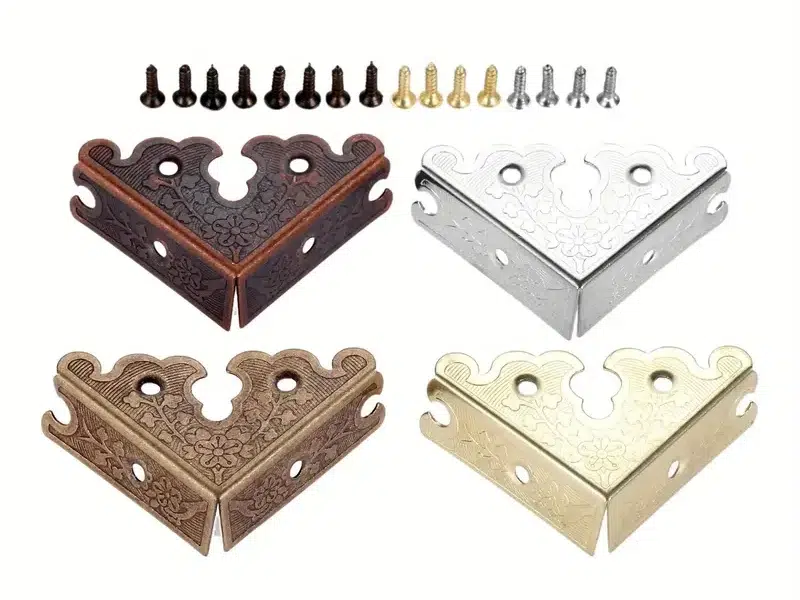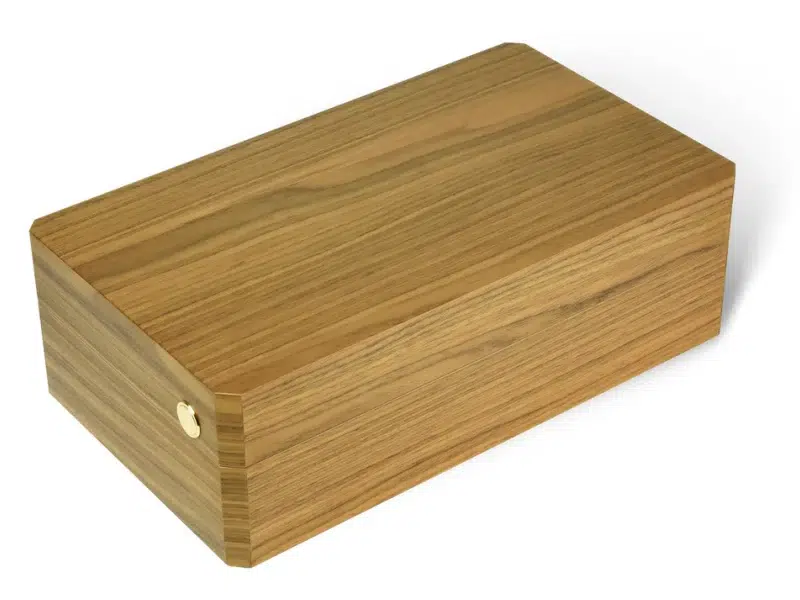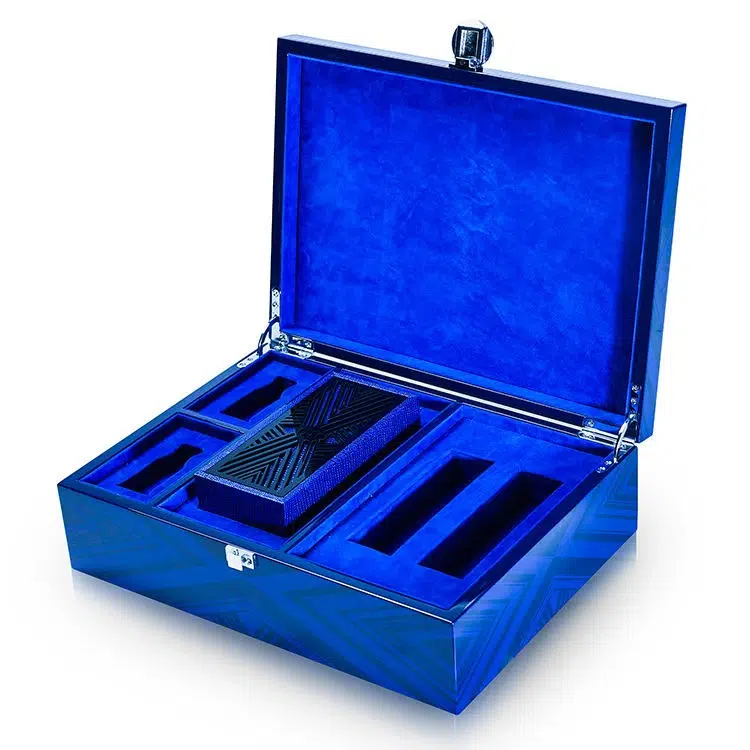
In luxury packaging, corners make the first contact—and they’re the first to show wear. Nothing undermines a premium unboxing experience faster than chipped paint at the edges.
To prevent corner chipping on luxury gift boxes, we must rethink design, materials, and finishing strategies from the inside out.
After years of crafting high-touch packaging for jewelry, perfume, and corporate gifting, I’ve learned that lasting elegance begins at the edges. Here’s how we protect them.
Why are corners and edges more vulnerable to paint chipping1 over time?
Corners are natural stress points. During handling, shipping, and stacking, they absorb the most impact, friction, and environmental exposure.
Key reasons for paint failure at corners:
- Sharp angles create tension lines in paint and lacquer layers
- Edges receive less coating coverage during spraying
- Frequent contact (especially lifting or opening the box) causes micro-abrasions
- Expansion and contraction of wood stresses surface layers over time
| Problem Source | Effect on Coating |
|---|---|
| Thin paint at edges | Exposes primer or wood grain |
| Sharp corners | Causes cracking or flaking |
| Impact during transit | Leads to chipping or denting |
| Heat/humidity changes | Accelerates adhesion loss |
I’ve seen boxes look flawless in QC, only to arrive overseas with paint flaked off at two corners—usually because of rushed finishing or sharp, unsupported geometry.
What design strategies can strengthen edge durability2 without sacrificing elegance?
Design plays a major role in how well corners hold up. Subtle changes in geometry and construction can dramatically reduce stress on painted edges.
Structural Tips:
- Add a slight radius (R1–R2 mm) to all visible corners—prevents cracking
- Avoid sharp 90° joins; use miters or rounded transitions when possible
- Use double-layer edge panels for structural strength
- Consider bevels or chamfers to disperse touch pressure
Aesthetic Strategies:
- Introduce contrasting material caps3 (metal, leather) at wear zones
- Add protective trim4 or decorative inlays to high-touch edges
- Choose matte or textured finishes where shine isn’t essential
| Design Element | Durability Impact |
|---|---|
| Rounded edge radius | Minimizes lacquer stress |
| Thicker edge material | Absorbs impact better |
| Chamfered edges | Deflects wear from contact zones |
✔ Elegant doesn’t have to mean fragile—smart geometry enhances both form and function.
For a fragrance brand’s signature wooden box, we added a 1.5mm corner radius and used a contrasting PU cap on the lid corners. Chipping complaints dropped to zero.
How do primer selection and edge preparation impact paint adhesion?
A finish is only as strong as the surface it grips. Edges, being thin and often over-sanded, are especially sensitive to poor primer absorption.
Primer Best Practices:
- Use high-build PU primers5 that can be sanded without losing adhesion
- Apply two light coats rather than one thick layer for better absorption
- Hand-sand edges gently with 400+ grit to avoid fiber exposure
- Seal corners with edge sealer6 before base coating
| Preparation Step | Benefit |
|---|---|
| Edge sealing | Reduces porosity and shrinkage |
| Proper sanding | Prevents coating failure at weak spots |
| Even primer thickness | Creates uniform adhesion base |
✔ Never leave MDF or veneer corners raw—even slight over-sanding can cause delamination later.
We always hand-apply extra primer to all edges before spraying—especially on multi-layer piano lacquer boxes. That base layer determines long-term survival.
What coating systems (e.g., PU, UV) provide better protection for high-touch areas?
Not all paint systems perform equally at stress points. High-quality PU coatings7 typically offer better edge retention than fast-curing or brittle formulas.
PU Coating (Polyurethane)
- Flexible yet hard—absorbs edge stress without cracking
- Can be buffed and re-coated if chipped
- Available in soft-touch, gloss, or matte finishes
UV Coating8
- Very hard surface, good scratch resistance
- But brittle at sharp corners—can chip under impact
- Requires perfect spray angle to fully coat corners
NC (Nitrocellulose) Coating
- Dries fast, easy to repair
- Not as durable, better suited for matte finishes
- Prone to edge shrinkage over time
| Coating Type | Edge Durability | Best Use Case |
|---|---|---|
| PU (2K) | High | Premium gloss or soft-touch boxes |
| UV | Medium-High | Flat-panel, high-volume projects |
| NC | Low-Medium | Lightweight or disposable packaging |
✔ Always layer a hard topcoat (PU or UV) over delicate metallics or stains for extra corner protection.
For cigar boxes with heavy lids and frequent opening, we now specify soft-touch PU topcoats for smoother feel and chip resistance at the hinge corners.
How can soft-touch or protective topcoats reduce surface wear on corners?
Beyond hardness, the tactile feel9 of a finish can also influence durability. Soft-touch or elastomeric coatings flex with the surface and resist abrasion from repeated handling.
Benefits of Soft-Touch PU:
- Absorbs friction instead of transferring it to the paint layer
- Feels luxurious and warm—ideal for perfume, watch, or jewelry boxes
- Less likely to chip or scratch at corners during daily use
- Can be applied in matte or satin gloss levels
Other Protective Options:
- Anti-scratch topcoats for UV or PU
- Textured coatings to hide wear marks
- Edge-only reinforcement layers under final topcoat
| Topcoat Type | Corner Protection Level |
|---|---|
| Soft-touch PU10 | Excellent |
| Glossy UV | Medium–High (needs precision) |
| Matte NC | Low |
✔ Combine function and feel—let your finish work with the user, not against wear.
One of our premium clients asked why a soft-touch box felt “softer” after two years. It wasn’t just the feel—it was the durability. That coating had flexed and aged gracefully.
What quality control and testing methods help identify weak points before shipping?
You can’t fix chipping issues after the product has shipped. The only way to guarantee long-term corner durability is through preemptive stress testing11.
QC Methods:
- Drop test12 from standard handling height (30–60 cm)
- Corner rub test using felt or leather friction tools
- Thermal cycling (simulate climate change in shipping)
- Visual inspection under raking light13 to detect micro-cracks
Inspection Checklist:
| Test Step | Purpose |
|---|---|
| Edge gloss check | Ensures even topcoat coverage |
| Adhesion tape test | Confirms coating grip on sharp edges |
| Final corner wipe test | Reveals loose particles or weak primer |
✔ Document QC batch reports with photo references
✔ Refinish or reinforce any unit with visible edge discoloration or uneven gloss
For luxury projects, we sometimes apply a final buffing wax at corners only. This adds just enough slip to reduce friction during packing and unpacking.
Conclusion
Corners aren’t just a structural detail—they’re the test of craftsmanship. In luxury gift boxes, edge durability is the fine line between elegance and early failure.
To prevent paint chipping at corners:
- Design smarter corners with radii, bevels, or reinforced materials
- Use high-build primers and seal edges properly before coating
- Choose PU coatings or soft-touch finishes for frequent handling
- Apply topcoats generously and evenly—especially at high-touch zones
- Test, inspect, and refine edges before the box ever leaves your workshop
Because real luxury is in the details—especially the ones that endure.
Brand Name: WoodoBox
Slogan: Custom Wooden Boxes, Crafted to Perfection
Website: www.woodobox.com
-
Understanding the causes of paint chipping can help you prevent it in your projects. Explore this link for detailed insights. ↩
-
Explore this resource to discover innovative design strategies that enhance edge durability while maintaining aesthetic appeal. ↩
-
Learn how contrasting material caps can protect high-wear areas and add elegance to your designs. ↩
-
Find out how protective trim can enhance durability and style in your furniture, ensuring longevity without compromising elegance. ↩
-
Understanding high-build PU primers can enhance your painting technique and ensure better adhesion for a durable finish. ↩
-
Exploring edge sealers can help you learn how to prevent porosity and improve the longevity of your paint job. ↩
-
Explore the advantages of PU coatings, known for their flexibility and durability, making them ideal for high-touch surfaces. ↩
-
Learn about UV coating's hard surface and its performance in high-impact areas, crucial for making informed choices. ↩
-
Understanding the role of tactile feel can enhance your knowledge of how finishes impact durability and user experience. ↩
-
Exploring the benefits of Soft-touch PU can provide insights into its effectiveness in protecting surfaces and enhancing product longevity. ↩
-
Understanding preemptive stress testing can help you implement effective quality control measures to prevent product damage before shipping. ↩
-
Exploring the drop test method will provide insights into its effectiveness in identifying product weaknesses before shipping. ↩
-
Learning about this inspection method can enhance your ability to detect micro-cracks and improve product quality. ↩





